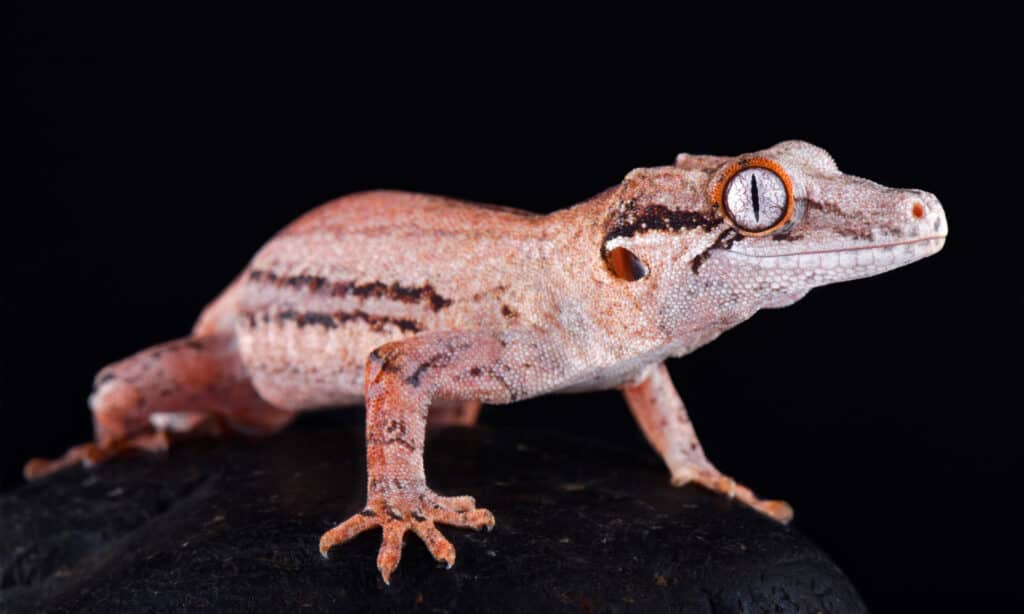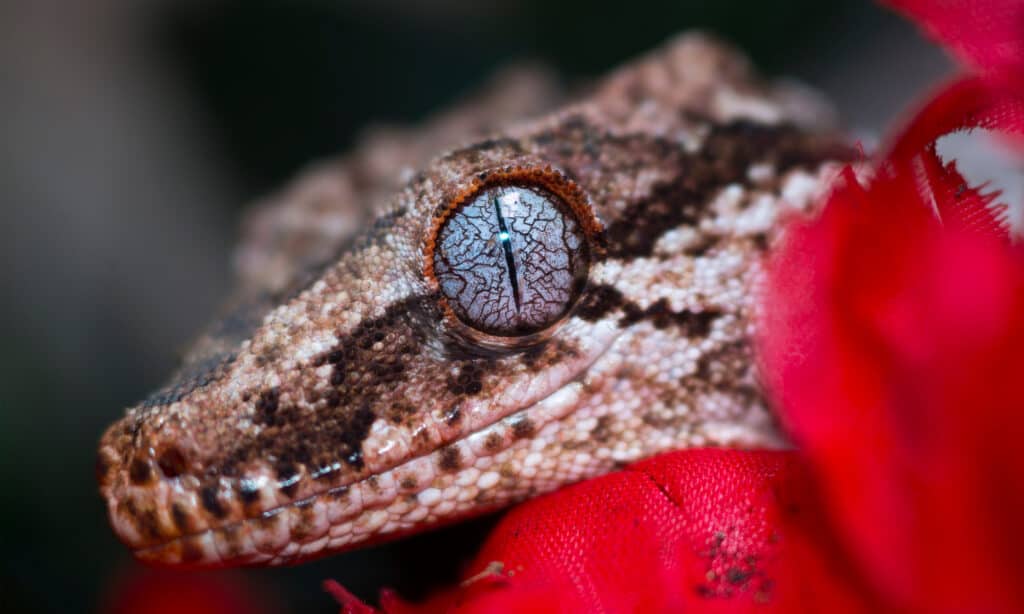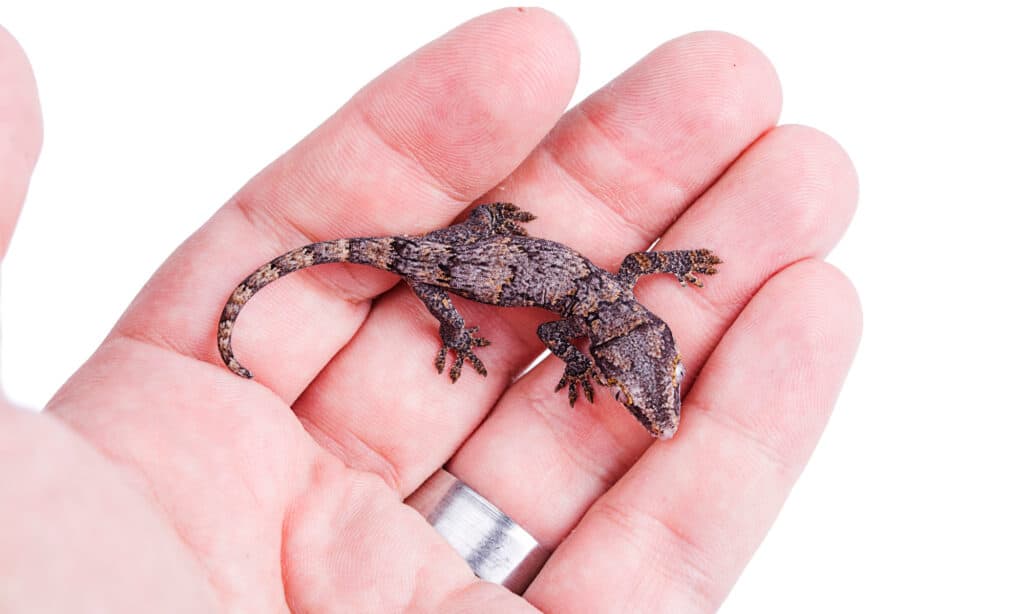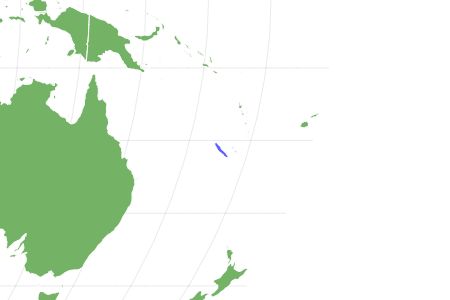Gargoyle Gecko
Rhacodactylus auriculatus
Gargoyle Geckos are about an inch long and weigh as little as 3 grams when they hatch!
Advertisement
Gargoyle Gecko Scientific Classification
- Kingdom
- Animalia
- Phylum
- Chordata
- Class
- Reptilia
- Order
- Squamata
- Family
- Diplodactylidae
- Genus
- Rhacodactylus
- Scientific Name
- Rhacodactylus auriculatus
Read our Complete Guide to Classification of Animals.
Gargoyle Gecko Conservation Status
Gargoyle Gecko Facts
- Prey
- Centipedes, small lizards, other geckos
- Fun Fact
- Gargoyle Geckos are about an inch long and weigh as little as 3 grams when they hatch!
- Estimated Population Size
- 10,000 or more in the wild
- Biggest Threat
- Cats, dogs, rats, small rainforest animals, habitat loss
- Most Distinctive Feature
- Horn-like knobs on the tops of their heads
- Distinctive Feature
- Prehensile tail that will regrow if it falls off
- Other Name(s)
- New Caledonia Bumpy Gecko and Knob-Headed Gecko
- Gestation Period
- 70 - 90 days
- Diet
- Omnivore
- Lifestyle
- Nocturnal
- Favorite Food
- In addition to centipedes, small lizards, and other geckos, Gargoyle Geckos eat flowers and sap.
- Common Name
- Gargoyle Gecko
- Nesting Location
- The female buries her eggs to keep them safe as they develop.
View all of the Gargoyle Gecko images!
These pocket-sized geckos are cute but also starting to experience trouble surviving due to their diminishing habitat.
With a broad range of colors and patterns, the Gargoyle Gecko is a fun pet. They live only in one area, New Caledonia. This French territory is located in the southwest Pacific Ocean, near Australia. This gecko calls this island home, although they have been exported to become pets around the world.
5 Gargoyle Gecko Facts
- These geckos are tiny, often weighing as little as 3 grams when they are born.
- Gargoyle Geckos can come in all sorts of colors, including orange, red, grey, brown, and white.
- They get their name from the gargoyle-like bumps on the top of their heads.
- Gargoyle Geckos can lose their tails and grow them back.
- They are nocturnal and most active at night.
Scientific Name
The Gargoyle Gecko goes by many names, including New Caledonia Bumpy Gecko and Knob-Headed Gecko. Its scientific name is Rhacodactylus auriculatus. It is a member of the Rhacodactylus genus. All species in this genus are geckos found in New Caledonia. Its family, Diplodactylidae, lives all over the region. Diplodactylidae geckos can be found in New Caledonia, Australia, and New Zealand.
They are part of the Squamata order, also called Squamates. This refers to reptiles with scales. Along with the Gargoyle Gecko, Reticulated Pythons and Frilled-Neck Lizards are also Squamates. The Gargoyle Gecko is a member of the Reptilia class, Cordata phylum, and Animalia kingdom.
Appearance
The first thing you will notice about a Gargoyle Gecko is its size. These geckos are small. Adults are between 7 and 9 inches long and less than one-quarter of a pound. After hatching, baby Gargoyle Geckos are closer to 1 inch long and 3 grams and are absolutely tiny!
Gargoyle Geckos are also recognized by the knobs on the top of their head that give them their name. They are located on their head where you may expect to see ears. There are two of them right on the top, similar to horns or ears in location only. However, these bumps do not provide hearing. They have small holes behind their large eyes. These holes actually connect to their auditory functions, which are internal.
They have a prehensile tail that can actually fall off and regrow. Dropping their tail is one way that these geckos escape from predators. It often happens when they are under stress, although it does not hurt them at all. The newly regrown tails are nearly identical to the ones that fell off.
Gargoyle Geckos don’t have a specific color or pattern. They are found in orange, red, grey, white, or brown. They can also be striped or speckled.

Geckos hear through holes behind their large eyes.
©iStock.com/reptiles4all
Behavior
You may have a difficult time finding these geckos during the day. Not only are they small, but they are also nocturnal and are most active during the night. They can climb vines and branches. Gargoyle Geckos like to live up in trees and plants. Like other geckos, they can jump quite far to get to the next branch or vine. Unlike some other geckos with stickier toe pads, they can’t climb up surfaces like glass, however.
When you do spot a Gargoyle Gecko on the ground, chances are they are looking for food or a mate. Due to their small size and normal location in trees, it’s not often that you find one of these geckos lounging on the ground.
Most gecko species lick their eyeballs to keep them clean. This includes the Gargoyle Gecko. This bizarre behavior is possible because they do not have eyelids. Instead, a clear membrane can move over their eye to keep them moist. They also shed their skin and often eat it to get nutrients.
Habitat

Gargoyle Geckos do not have eyelids. Instead, they have membranes that keep their eyes moist.
©iStock.com/Rafael Cutó
These geckos live in a very specific area. Gargoyle Geckos live primarily in the southern third of Grande Terre. Meaning “Large Earth,” this island is the largest in New Caledonia. The tropical rainforests in this part of the world have plenty of trees and vegetation that are ideal for Gargoyle Geckos’ habitat.
Gargoyle Geckos are also popular pets. They are easy to care for and have an interesting appearance. While they were once considered rare and exotic, they are now becoming more and more common around the world in captivity. All Gargoyle Geckos can trace their lineage back to New Caledonia, although many are bred in captivity for pets. Grande Terre island is still the only place they are found in the wild.
When kept as pets, look for a tank that is at least 20 gallons. This provides plenty of space for your gecko to explore. Outfitting your tank with branches, vines, and other plants is also important to replicate their habitat in the wild. Tropical plants are the best option.
Diet
These geckos are omnivores and eat both plants and animals. They do not need to eat a lot to maintain their size but do eat frequently. They are known to eat centipedes, small lizards, other geckos, flowers, and even sap. They often travel down to the rainforest floor to look for food and eat. They will eat on branches and vines, however, as long as they can stay in one place.
In captivity, crickets make an ideal food for Gargoyle Geckos. You can also feed them powdered gecko food as their primary food source or as a supplement. This specialty food includes added nutrients that they need to stay healthy. Try to feed them some live food, however, to allow them to catch it like they would in the wild.
Gargoyle Gecko Predators and Threats

Gargoyle Geckos are popular pets that only grow to 7 – 9 inches long at maturity.
©iStock.com/Kaan Sezer
Other animals like cats and dogs are the most common predators in New Caledonia for Gargoyle Geckos. Rats and other similar-sized rainforest animals eat Gargoyle Geckos. These geckos will drop their tails to escape. The tails actually continue to move, which prompts the predator to go after the tail instead of the gecko.
The loss of their habitat also impacts the Gargoyle Gecko population in the wild. Because they have such a small natural habitat, even a small change in the rainforest can have a major effect on these geckos.
Due to their desirability as a pet, some people keep and breed Gargoyle Geckos. This keeps them from becoming endangered or even extinct. It is still important to only get pets from a reputable breeder that maintains safe and sanitary conditions and does not take geckos from their natural environment.
Gargoyle Gecko Reproduction, Babies, and Lifespan
Gargoyle Gecko babies are tiny and adorable, at least for a gecko. When they hatch, they are around 1 inch long and can be as small as 3 grams. After around 18 months, they weigh around 30 grams and are ready to mate. Gargoyle Geckos spend most of their lives in the trees but come to the ground to mate.
The female Gargoyle Gecko lays two eggs, burying them to keep them safe and to encourage the babies inside to grow and develop. They hatch after 70 to 90 days and emerge, ready to eat. A single female Gargoyle Gecko may lay eggs up to 10 times in her lifetime.
Gargoyle Geckos live up to 20 years or more in captivity. Maintaining the right environment and diet are important to ensure your pet gecko lives a long and healthy life. In the wild, they likely live shorter lives, often around 10-15 years.
Gargoyle Gecko Population
Although they have a limited habitat in the wild, scientists are not concerned about the Gargoyle Gecko population numbers. They are considered a species of “least concern” on the endangered species list. Researchers do not know exactly how many of these geckos exist in the wild but they estimate the population at 10,000 or more.
Keeping these geckos as pets actually helps maintain the overall world population. Just make sure to get your gecko from a dealer that keeps their geckos in safe conditions.
Gargoyle Geckos in the Zoo
These geckos make fun additions to a zoo’s reptile house. They are fun to watch and are at home in engaging exhibits due to their lifestyle of living in trees. Their interesting coloring and bumpy heads are two other reasons why visitors like to see them. They have a diet like many other geckos, making them easy to care for as well. The Louisiana Purchase Zoo & Gardens has Gargoyle Geckos on exhibit.
Gargoyle Geckos are commonly kept as pets, even by those without much experience caring for geckos. They only require a basic setup and standard gecko fare.
Similar Animals
To learn more about geckos, check out these fascinating species:
View all 170 animals that start with GGargoyle Gecko FAQs (Frequently Asked Questions)
Is a Gargoyle Gecko a good pet?
Yes, these geckos make great pets. They are easy to care for, eat food that is available in most pet stores, and are fun to watch. They often have bright colors, such as orange and red, which are interesting.
How big do Gargoyle Geckos get?
Adult Gargoyle Geckos can be 7-8 inches long and weigh around 70 grams. They are considered adults when they reach 30 grams, which is usually between 15 and 18 months old.
Thank you for reading! Have some feedback for us? Contact the AZ Animals editorial team.
Sources
- The Links Road Animal and Bird Clinic, Available here: https://thelinksroadanimalclinic.com/2022/02/28/february-2022s-animal-of-the-month-gargoyle-geckos/#:~:text=Gargoyle%20geckos%20have%20a%20small,the%20openings%20for%20their%20ears.
- Reptiles Magazine, Available here: https://reptilesmagazine.com/gargoyle-gecko-care-sheet/
- KNOE News Coverage, Available here: https://www.knoe.com/2022/04/12/zoo-buddies-gargoyle-geckos/

















